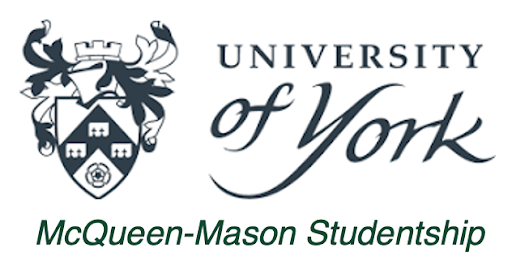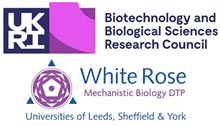Yorkshire Students
University and Industry funded studentships
Targeting altered glycan profile for improving prostate cancer treatment

Jess Peng, Medical sciences, Newcastle
Investigating LPS sensing in human immunity to induce programmed cell death

Dr. Davey Kneafsey, Dept. Biology, York
Novel genetic control of Aedes aegypti using CRISPR/Cas9-based gene drive system

Dr. Eunice Adedeji, Dept. Biology, York
Comparing microscopy modalities in breast cancer for image analysis with CellPhe

Dr. Jodie Malcolm, Dept. Biology, York
Lighting the LAMP: A rapid diagnostic tool to detect S. aureus during infections

Dr. Ian Hurley, Biomedical Sciences Dept., Leeds
Deconstructing biofilms to understand antibiotic resistance

Dr. Agnes Noy, Dept. of Physics, York
UV controlled dynamic covalent systems in supramolecular chemistry

Dr. Andrew West, Dept. of Chemistry, York
The Laboratory of Molecular Biology, Cambridge, provided by the Max Perutz Fund

Laboratory of Molecular Biology
Understanding stem cells: Cutting edge technologies in multi-parameter and spectral flow cytometry

Dr. Sukhveer Kaur Mann and Prof. David Kent, Dept. of Biology, York
Investigating Environmental Microbes in Newcastle using Nanopore Sequencing

Dr. Matt Bawn Dept. of Environmental Sciences, Newcastle
Developing innovative techniques to monitor chemical and microbial pollution

Harriet Sleight, Dept. of Environment and Geography, York
Expanding expansion microscopy: Transforming plant bioimaging

Dr. Lydia Kitchen Dept. of Biosciences, Durham
Studying the role of plasmid transmission in lung disease

Prajwal Vishwanath Bharadwaj, Agriculture, Vet, and food science, Liverpool
The challenge of battery recycling and the Role of Modelling

Dr. Elham Hosseinzadeh, Dept. of Physics, Engineering and Technology, York
Evaluating the effectiveness of the Food Standards Agency (FSA) school food standards compliance pilot questions

Dr. Michelle Patel and Nicola Nixon, Dept. Health Sciences, York
Assessing microscopy methods to study cellular organelle structures necessary for life

Dr. Simon Walker, Babraham Institute, Cambridge
Effects and optimisation of a new compound on live cells using the very latest bioscience technologies

Dr. Karen Hogg, Biology, York
Developing tools to identify immune cells involved in parasitic disease

Helen Sanders, Dr. Cecile Crosnier, and Dr. James Hewitson, Dept. of Biology, York
Imaging, manipulating and measuring HeLa cells

Dr. Chengxi Zhu, Advanced Imaging Centre, Cambridge
Understanding the value of community food programmes

Prof. Bob Doherty, School Business and Society, York
An introduction to the role of animal technologist in biomedical sciences

James Cruickshank, MRC Laboratory of Molecular Biology, ARES Animal Facility, Cambridge
The protective role of PNN in neurodegenerative diseases

Stuart Dickens, Biomedical Sciences, Bradford
Enhancing research culture: A collaboration with Sense About Science

Dr Alex Reid, Dept. Psychology, York
Using genetically altered mice to understand human disease

Dr. Sara Wells, Mary Lyon Centre, MRC, Harwell
Deep Learning to explore collagen microfibril assembly and protein engineering

Dr. Mitya Pushkin, Dept. of Maths, York
The Puppet Master: Global virulence regulators in nasal colonisation by S. aureus

Dr. Arya Gupta, Biomedical Sciences Dept., Leeds
Artificial intelligence (AI) decision support tools for local food systems

Prof. Phil Garnett, School Business and Society, York
BBSRC Studentships: the building blocks of life
Investigating the future: Carbon fixation in brown macroalgae

Dr. Charlotte Walker, Dept. Biology, York
Evaluating the antimicrobial effects of peptides against oral pathogens

Dr. Isabel Fernandes Parreira, Dentistry, Sheffield
Ensuring food security for the future: Novel crop protection strategies

Dr. Sam Wilkinson, Dept. Biology, York
Determining mechanisms that dictate mycorrhizal-induced resistance or susceptibility

Dr. Christopher Bell, Biology, Leeds
The guardian of the cell surface: Understanding transport across the glycocalyx

Jelizaveta Pavljuk, Biomedical Sciences, Leeds
Unlocking channels for communication in plant sciences

Dr. Yoselin Benitez-Alfonzo, Biology, Leeds
Investigating the role of bioenergetic complexes in Mycobacterium tuberculosis

Dr. Morwan Osman, Dept. Biology, York
Enhancing plant growth-promoting effects of soil bacteria for bio-fertilisers
Sophie Groenhof, Biosciences, Sheffield
Tackling the climate crisis: Characterisation of new algal carbohydrate active enzymes

Aidan Salter, Dept. Biology, York
Using high molecular resolution microscopy tools to visualise Streptococcus pneumoniae

Dr Laia Pasquina-Lemonche, Biosciences, Sheffield
